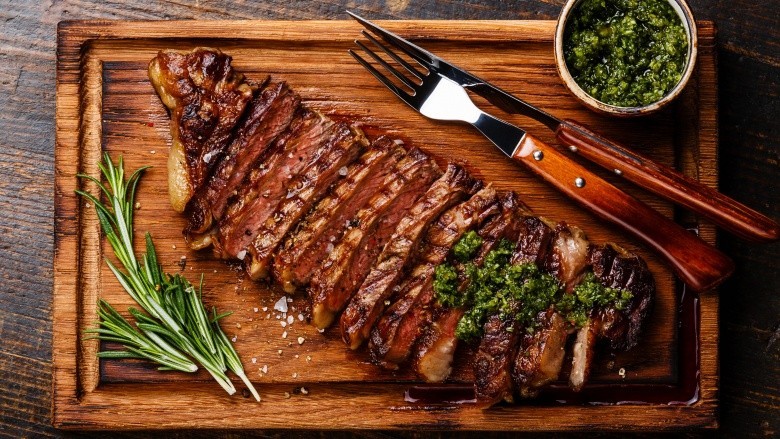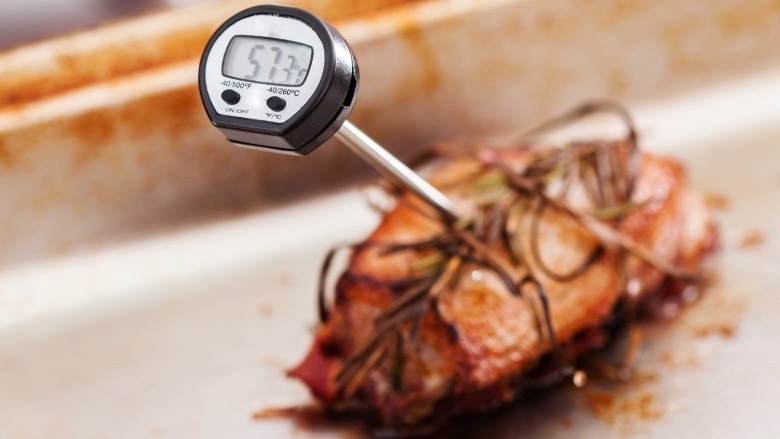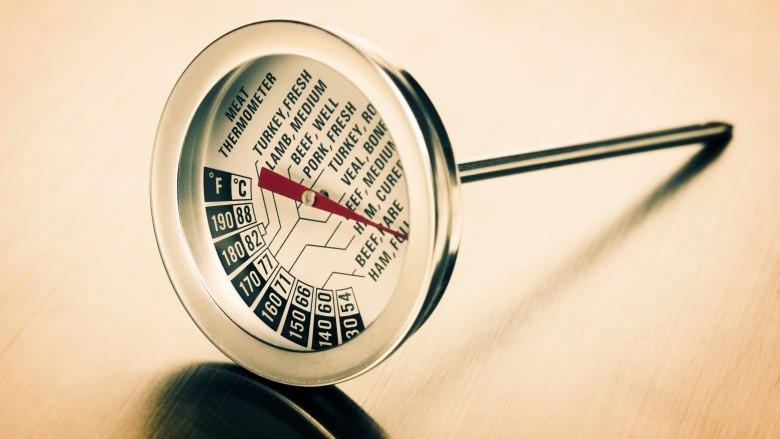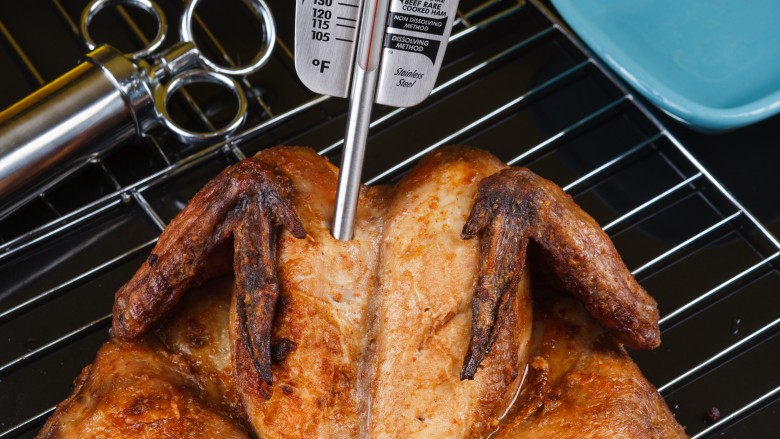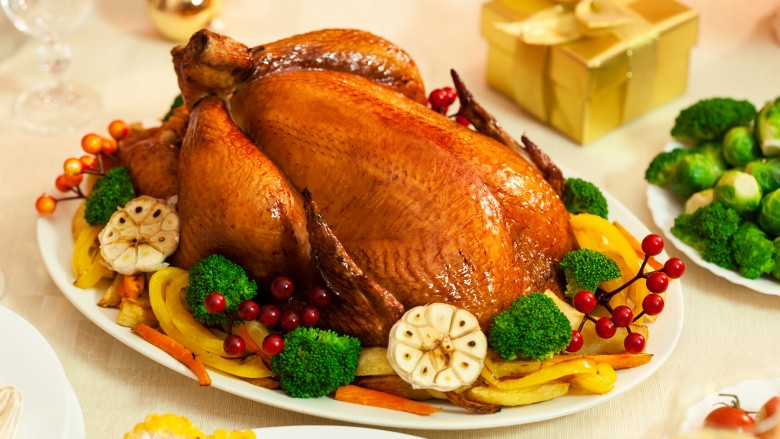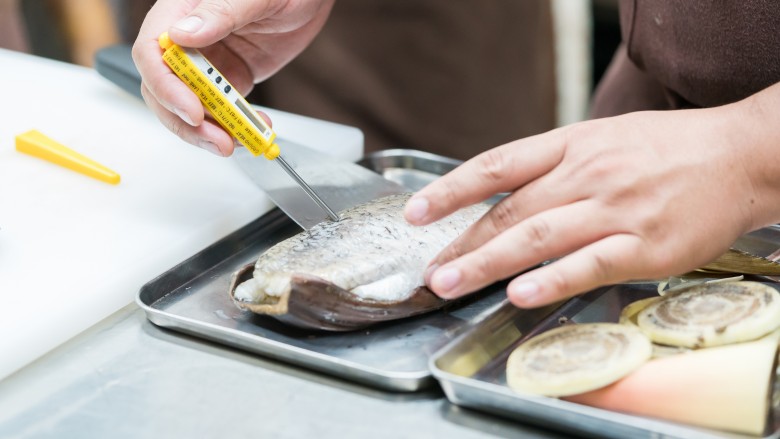How To Tell If Your Meat Is Cooked Without Cutting It
How can you tell if your meat is cooked without hacking it to tiny pieces? Since consuming raw or undercooked food is dangerous and can expose you to foodborne illnesses, you should err on the side of caution. You don't want to hack your nice cuts apart, and if you just cut into the thickest piece of meat you're cooking, the thinner ones will be overdone by the time that one's ready. You can't always discern if meat is cooked properly by only looking at it, although visual cues for doneness can help you make that determination.
The next time you serve up some hearty protein for dinner, try out these two important go-to methods to help you avoid eating anything undercooked. Enjoy your dish safely and keep that glorious mealtime Insta shot intact every time.
Hot enough in there?
If you aren't so sure about the hand test, there are other ways to test for meat doneness that don't involve slicing it open. The best way to do so is by using a thermometer because it takes away any uncertainty. When it comes to food safety, better safe than sorry. Use a meat thermometer first and foremost as well as your own judgment — by doing both, you ensure absolute doneness without overcooking.
Invest in an instant-read food thermometer. It's a relatively cheap kitchen tool that becomes very useful when you're trying to figure out if your meat is finished cooking but don't want to cut into it before serving. The USDA has specifications for meat and poultry safety that help you to determine if your meat is cooked to the right internal temperature for consumption, taking away a lot of the guesswork. Note that following proper resting times allows the meat to continue cooking off the heat.
Beef, pork, and lamb cooking temperatures
To test steaks, chops, and roasts for doneness, simply insert the thermometer into the center at the thickest part of the meat. Your thermometer should read 145 degrees Fahrenheit before you serve the steak. Keep in mind that meat continues to cook for a few minutes after you remove it from the heat. As such, you may want to take it off the heat just before the internal temp reaches 145 degrees and set it aside to rest for 3-5 minutes. Check the meat temperature again before serving to ensure it has reached the safe number. While some people enjoy having their steak rare, there is a greater danger of foodborne illness since rare meat is between 130 degrees and 140 degrees. Eat at your own risk!
Rare and medium-rare steak
However you like your steak prepared, you'll find the time-honored "finger test" helpful in determining if it's done to your desired preference.
Open up your hand so that your palm is facing up. Relax it and use the index finger of your other hand to press slightly below the base of your thumb. You'll feel that it's soft and squishy. If your meat feels this way to the touch, then you'll know it's still raw inside. You should probably not eat it. Has it even been on the heat for two minutes? Be patient.
If you like your meat rare, keep in mind the food safety risks. Open your hand once again and relax it, then gently touch the tip of your index finger to the tip of your thumb. The area you previously touched below the base of the thumb now feels a little firmer and has some tension to it. That amount of give with your meat indicates that it's rare.
Press the tip of your middle finger to the tip of your thumb and using the index finger of your other hand, touch the same spot below the base of your thumb. A medium-rare steak will have this amount of give.
Medium and well-done steak
This finger test or hand test keeps working all the way across your hand. Press the tip of your ring finger to the tip of your thumb. The amount of bounce-back you feel when you touch the spot below the base of your thumb is what a medium steak should feel like to the touch. For steaks that are well-done, touch the tip of your pinky to the tip of your thumb. Here, you'll feel the most tension.
You can look at your meat and lean in to sniff it. And you can certainly learn what different levels of doneness feel like to the touch. Visual and olfactory cues, along with a little poking, are good indicators of when your meat has finished cooking. But to stay on the safe side, it's crucial that you also check the internal temperature with a thermometer.
Chicken
When you're cooking whole chicken, measure the temperature in the thigh region near the breast. For chicken parts and thinner pieces, you can insert the thermometer horizontally. The safe internal temperature for all types of poultry is 165 degrees Fahrenheit. Other signs of doneness? The chicken should be a little smaller since shrinkage is supposed to occur. If it hasn't shrunk, chances are it isn't finished cooking. And while some people believe juices running clear indicate doneness, it isn't a guarantee, so it shouldn't be relied on as a test of doneness.
Turkey
When you're cooking whole turkey, you should measure the temperature in the same way you do with chicken. Because turkeys are larger than chickens, be sure to check the temperature in several places, keeping in mind that it may take several hours to cook at a low temp. It's finished cooking when the internal temperature at the thickest part of the thigh reads 165 degrees Fahrenheit. And that legend about juices running clear? Same as for chicken. It doesn't mean the meat is finished cooking. Always check the temperature!
Fish and shellfish
Generally speaking, most types of fish take a short amount of time to cook, which means it's extra important to be vigilant. No one likes overcooked seafood. Fish is relatively transparent when raw, so you want to make sure to cook it until the flesh becomes just opaque all the way through. Shrimp curls up into a C-shape and turns a bright pink color when it's finished cooking. Scallops are done if the flesh bounces back slightly when poked with a fork; they should no longer feel mushy in any way.
When cooking a whole fish, use your thermometer for absolute clarity. Insert it away from the backbone into the thickest part of the fish. Since the USDA recommends cooking fish and other seafood to 145 degrees Fahrenheit, remove the fish from the heat at around 135 degrees. Doing so allows the retained heat to continue cooking while the fish or shellfish rests for a few minutes. By the time you're ready to serve, the internal temp should have reached 145 degrees.
